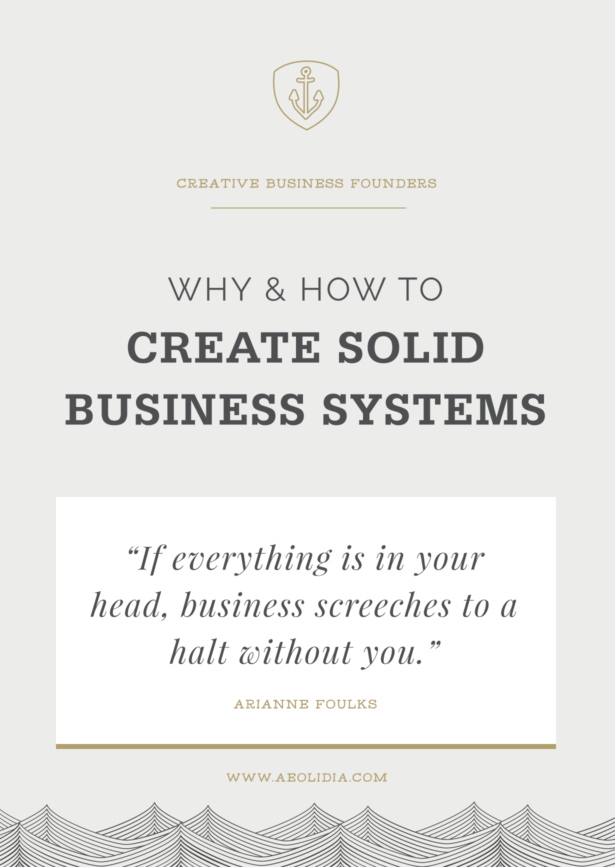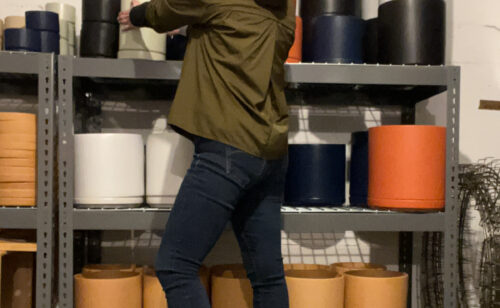

Creative business owners: join me to shape up our businesses! I have written an eight part series that will help you:
- Increase efficiency and focus,
- Enjoy your work more,
- Reach your goals,
- Learn to quit trying to do every darn thing that goes into running a business yourself!
Previously:
How to Build a Successful Creative Business on Limited Time
How to Find Time by Cutting Back on Reactive Work
Shift Into CEO Mode and Get Help With the Rest
Kill Your To-Do List and Focus on ONE Thing
What Happens When We Resist Delegating Business Tasks
How to Make Time & Enjoy Your Work by Hiring Help
Creating systems for your business
When time is limited (and when isn’t it?), you need good systems in place. You can’t do things differently each day or for different customers. You can’t answer the same question from scratch every time, write up a wholesale invoice starting with a blank page, or create a new process for each custom order. Creating systems for your business is a step you shouldn’t skip. Everything that can be systematized, templated, or automated should be.
You can use form letters but still have a personal touch. You can start from a template and adjust it to fit your work. You can structure your work day in a way that is consistent from day to day and week to week. You’ll find yourself saving time by not repeating your work over and over, but instead re-using it. Instead of having to figure out how to do a task each time it comes up, you can follow a system you developed the first time.
Why do you need systems?
As a sole proprietor of your business, everything is in your head! That means that without you, business screeches to a halt. You have no good way to go on vacation, recover from an illness, or deal with a family emergency.
If you can get your systems out of your head and onto paper (or Evernote, or a training video), you can get help. You can do anything from get a friend or family member to fill in when you need a break to hire a team of employees to manage everything. Systems leave you free to grow your business.
When it’s just you, you need systems to work more efficiently. It is always faster to batch similar tasks. Your chance of making a mistake during production is high without a system. You won’t have to worry about missing a step when shipping orders if you have a checklist of tasks to use each time.
If you have documented, repeatable systems, it will be much easier to hand these jobs off to a new employee. If you don’t have systems in place, hiring someone is the perfect time to create them. I wouldn’t recommend delaying hiring help if you need it. Instead, hire your help and work with her to create and document your systems.
Teach your new employee what to do, work with her to create systems where you have none, and have her write down the steps to make them repeatable. It will feel like a lot of extra work this first time. However, when you’re ready to hire again, onboarding will be a piece of cake.
Evaluating your current systems
One way to start creating systems is to imagine you’re going to go on vacation for a couple of weeks. Come up with a set of instructions for your replacement so she could run your business while you were away. If you could write these instructions up easily (or they’re already documented), you’ve got great systems. If you couldn’t describe to someone else how to do what you do, your method needs some work.
What processes could you systematize?
In an ideal situation, you would have a system for everything you do for your business. If you’re just starting setting up systems, consider these as good places to start:
- Product creation/production
- Product packaging
- Photographing products
- Adding product info to your website
- Fulfilling and shipping orders (wholesale and retail)
- Customer service
- Social media and marketing
- Blogging and promotion
- Tracking inventory of products and supplies
- Managing wholesale orders and relationships
- Tracking finances and bookkeeping
Often, as you look into these things, you will be able to find software to help you automate part or all of the job.
How do you begin documenting your process?
You likely have a repeatable process for some or all of the above, but haven’t documented it. For those processes, you can take some time to take notes as you go through the set of tasks needed to accomplish the job. You’ll want a simple list of ordered steps that someone else could learn to follow. As you’re doing this, see if there’s a way to do something more efficiently or cut out unnecessary steps.
For anything you do haphazardly, inefficiently, or differently every time, develop a system. Consider the final outcome you want, and work backward through what you’d have to do to get to that point. Try out your process a few times to see if it feels right.
Once you’ve written down the steps and instructions for each system, try following them to the letter. This will help you see if you missed anything. Create checklists, and if you find yourself doing something that wasn’t on the list, adjust your list. If you find that there’s a step you keep skipping, it may be something you don’t need to do.
As you’re testing out your system, you may notice missed steps or mistakes. You may find yourself going back over and over to look up the same information. When problems arise, add in a step to prevent the trouble. You want your systems to be foolproof. You want to know that you could entrust this documented system entirely to someone else. No part of it should live solely in your head anymore.
Want some specific examples?
When planning this article, I asked the smart business owners in the Aeolidia Facebook group about their systems. Below are a few of their systems:
I have a calendar, and a binder with 31 tab dividers (numbered 1 – 31 for the days of a month) in it. Orders are filed in the binder by the promised shipping date. I use the calendar to mark when I ordered supplies (and quantity) so I know that was done. I also put other appointments in it for reference.
It’s a pretty simplistic, non computerized method, but I don’t like not being able to access info when the power / internet is out (this happens often unfortunately). And I can carry the binder to places like kid’s practices or the park during the summer so I can flip through orders and make pertinent notes.
I keep the calendar at the front of the binder. It also helps me plan when I know I need to schedule dead time for an appointment, etc.
— Leeanna Prejean of Lemon Lime Creations
We just got Stitch Labs to help us with our inventory system! I’m pretty big on accounting systems right now too! I’ve been setting up lots of Excel spreadsheets with all the equations and I feel so smart!
I have a checklist system for our quarterly product launch so that I know when everything needs to be done, sent to the printer, photographed, listed, emailed to wholesalers and then promoted direct to consumer! I put the checklist on a calendar (digital and paper) so I cut down on my stress by being planned and prepared!
I also set up lots of Photoshop actions to save time on repetitive editing! I think I’d even call our scheduling a system. Every Monday my husband and I meet in my studio and go over who is working on what each day so we are efficient and held accountable. We also have habit forming scheduled things like going over our accounting once a week to make sure quick books labeled everything right etc so we make fixing things manageable.
— Kaitlin Phillips Goodey of Goodey Studio
I use paper because my product is so labor intensive and customized I try not to have more than 8 in the works at a time, so spreadsheets and inventory apps don’t really work for me. I use Apple’s Pages and make an order sheet for each Etsy order, with standard drag and drop place holders for photos, notes, due dates, etc.
I have 8 clipboards on the wall behind my sewing machine and one order is clipped to each. Since my dolls take 6-8 hours a piece, I do not have more than eight “active” dolls going at once. If I’m wondering what color leggings or hair flower a particular doll had I just swivel around and check that clipboard.
— Lisa Press of Phoebe & Egg
I hired a virtual assistant to help me get my products uploaded. It took a long time to get the system set up, but now I don’t know how I lived without it.
I use a combination of Asana and Dropbox. For each product type I set up master tasks with subtasks starting with creating the templates, writing the product copy and getting it translated (my tasks) then creating photograph mockups, uploading the products to my store, my Etsy store and any other marketplaces, scheduling pins, tweets and a facebook post and setting up a blog post.
It has exponentially increased my velocity to get products live. She and I are like a MACHINE!
— Eleanor Mayrhofer of e.m.papers
Fascinating! If you’d like to read more, we discuss things like this in our Facebook group all the time! Please join – I approve product-based creative businesses right away.
Your homework
This week:
- Choose the most important or least-systematized of the regular jobs you do for your business.
- Consider the desired outcome, and plan steps backwards from there.
- Test out your documented steps to see if the system is repeatable.
- Either move on to documenting the next job, or get some help for the first one.
Ready, set go! Then, when you’ve accomplished this, let’s celebrate and support each other in the Aeolidia Facebook group for creative business owners!
The Founder’s Bookshelf

These are all books which have significantly influenced Aeolidia for the better, and which I recommend to any business owner.
3 thoughts on “Do You Have Solid Systems for Your Business?”
Leave a Comment
Related Posts
Let's take your online shop to the next level
The Shopify websites we design have a reputation for substantial improvements to ecommerce conversion rates and online sales. Let's talk!
















Arianne, this whole series is terrific. I especially like how you broke down business operations that could be systemized into a list. The list made me realize the areas I still need to systemize, like blogging. Thank you! And thanks for including Phoebe&Egg.
Hi Lisa,
Yes, we have a checklist for everything that must be done to turn an idea into a blog post. There’s so much to it that it’s easy to forget a step or two without the process written down.
It really helped when you talked about how having a business system will minimize the risks of creating mistakes during the production. With that in mind, I will have to convince my partner that we undergo a business system training before we launch our online clothing shop. We didn’t graduate with business courses, so I think it is really essential to do so. We’ve just decided to start this shop because we both love creating clothes. With this tip, we will be able to reach our dreams in the future. Thanks!